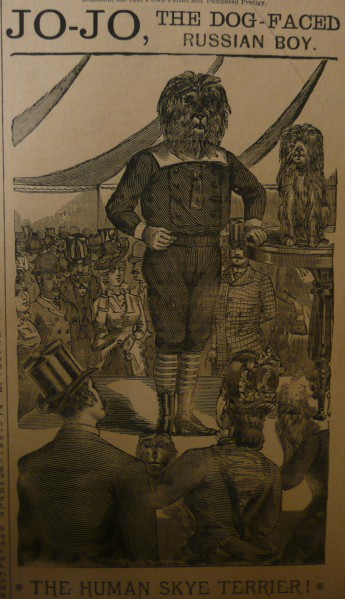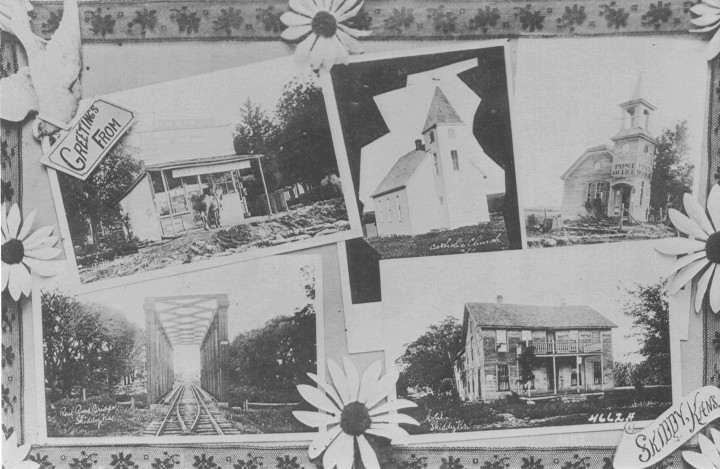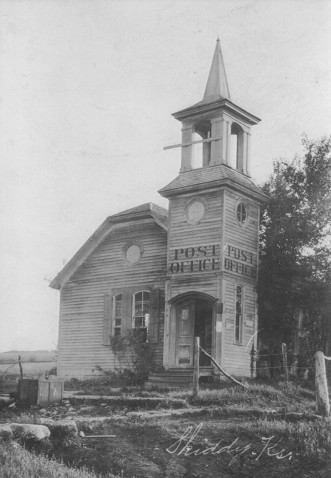There are a number of old trails that cross Morris County. Some we are familiar with and others we know very little about. I would like to take some time for us to learn a little more about these various trails and what they were used for.
The first trail I’ll mention is the Santa Fe as it appears to be the first major trail. It is very accurately mapped and we know a good deal about it, so I won’t go into much detail on it. In the early 19th century a number of adventuresome individuals were trying to find a good route to Santa Fe in order to establish trade with the south and west. William Alexander Becknell was fortunate enough to be the first to arrive in Santa Fe with his men in November of 1821. He has ever since been known as the father of the Santa Fe Trail.
Becknell had not had very good luck up till this point. Around 1818 he had bought the Boone family’s salt works near Arrow Rock Missouri. In 1820 he ran for the Missouri legislature and borrowed money to do so. He was unsuccessful and the panic from the previous year had already taken a huge toll on his pocket book. Owing his creditors more than $1,200 he was thrown in jail until a friend bailed him out. So, you can imagine the troubles that weighed on Becknell’s mind as he headed out across the godforsaken prairie. Failure was not an option, he had to come home with something. And he did! The people in Santa Fe paid handsomely for his merchandise, and he returned to the States with his saddle bags loaded with silver.
One thing I would like for us to consider is the fact that not everyone who traveled the Santa Fe Trail was necessarily going to Santa Fe. Like many of our highways today, such as 56 and 77 south of Herington, many of the old trails intersected and even converged. Some travelers on the Santa Fe Trail were going down to Chihuahua in Mexico to trade. Some were going on to southern California by way of the Gila Trail. Others might find their way to California by taking the Old Spanish Trail which led up through Colorado and Utah by various routes. Although the Mormon Trail ran through Nebraska and followed the Oregon and Old California Trails, in the 1840s Mormon immigrants would be using the Santa Fe Trail. We know that in August of 1846 the Mormon Battalion passed through Council Grove taking the Santa Fe Trail on their way south during the Mexican-American War. John Maloy states that during the year of 1860 an average of 50 wagons per day were passing through Council Grove on their way to Pike’s Peak. Also, we cannot claim the only Santa Fe Trail. There was a lower route, known as the Fort Smith route, which passed from Fort Smith Arkansas through Oklahoma to Santa Fe.
The Kaw Trail is the next oldest trail in the County. It was put into use about the time the Kaw were moved to the reservation in Morris County in 1847. The treaty signed with the Osage in 1825 in Council Grove, made the Santa Fe a right-of-way for the white man and the Indians were not suppose to utilize it. Because of this, the Kaw Trail ran about a mile south of the Santa Fe Trail but nearly paralleling it. It started at Big John Creek south of Council Grove on the Kaw reserve. It passes through the counties of Morris, Chase and Marion where Florence now stands and continued on west to Turkey Creek where it intersected the Santa Fe Trail. Some remnants of this trail can be seen near Diamond Springs, and Florence. The trail was used by the Kaw going and returning on their annual buffalo hunts out west. John Maloy, in his History of Morris County, gives a description of the Kaw returning from one of these hunts. In April of 1869 “the Kaw Indians returned from their winter’s hunt on the plains, looking gaudy and feeling gay. They had plenty of robes, and their accustomed business of pony stealing had proved both successful and lucrative. They were met by those who staid (sic) at home with an ovation and the biggest thief, according to custom was permitted to wear a pair of polished horns.”
The next trail we have of significance goes by a few different names; the Ft. Scott & Ft. Riley Road*, the National Historic Military Trail or the Government Trail. We may with reason date the beginning of this trail with the birth of Ft. Riley in 1852-53. This trail leads from Ft. Riley and passes near Skiddy, White City, Kelso through Council Grove and on southeast to Ft. Scott. There were two branches of this trail. The previous mentioned which followed the Santa Fe Trail for a short distance west of town and the second which takes a more northerly route out of of Council Grove. It is possible that goods were hauled from Ft. Riley to Council Grove by this road. We know that in April of 1854 the 79 ton stern-wheeler Excel made her first run on the Kansas River from Weston Missouri to Ft. Riley. She was carrying 1,100 barrels of flour. More steamboats were employed until trade on the Kansas River finally came to an end along with trade on the Santa Fe Trail in 1866.
There is a trail shown on an 1856 map in my possession that enters Council Grove from the northeast. I have not been able to determine the name of this trail. It passed from Uniontown through or near present Alma to Council Grove. To the best of my ability, I have determined that Uniontown was south of the Kansas River on Vassar Creek approximately 2 miles west of present Valencia. Also on this map, is a road that at one time passed through the northeast corner of Morris County. It begins at 110 mile station, simply marked ‘110’ on the map, also on the Santa Fe Road. From there it heads west and slightly north a few miles from Council City, now Burlingame. The trail passes a little south of present Eskridge then runs west until approximately the present Morris/Wabaunsee County border just a little south of Alta Vista. From there it starts veering north and eventually converges with the Ft. Riley Road. Since the county boundaries have changed in the northeast corner, we have lost most of this old road. The Kansas Cyclopedia of 1912 identifies this road as one of the many lesser branches of the Mormon Trail.
One of the trails we know least about, and I know so little about it I’m almost embarrassed to mention it, is the Shawnee Cattle Trail. This trail was brought to our attention a couple of years ago when a man who was very knowledgeable on the subject came to the Historical Society to research it. He seemed certain that the trail passed through Morris County, and I have found two generic maps of Kansas that show a lesser branch of the Shawnee Trail passing through the area that Morris County would occupy on the map. This was a north-south trail that went down through Texas to Dallas and Waco. We do know that some time in the 1870s Council Grove passed an ordinance to prevent cattle drives from coming through the city. We can safely assume from this that the trail did not come through Council Grove. A map of historic trails provided by the Kansas Department of Transportation, shows Cottonwood Falls as a trail head for the Texas Cattle Trail. Again, I don’t pretend to know much about the Shawnee Trail, but with the Texas Trail so close to us, it makes sense that the Shawnee Trail passed through here and may well have joined with this Texas Trail.
*Actually appears as Council Grove Ft. Riley Road on the 1856 map, I have also seen another map of the same year by the same maker but the road appears as C Grove Ft. Riley Road. I question how accurate the map is as many of the towns and stream names are no longer the same, and in fact it shows Big John and Little John near Council Grove reversed.
I have a little more information to include about our local trails thanks to Larry Timm who has loaned me some maps he’s acquired during his research on the Military Trail. There are a number of different maps that show trails and roads criss-crossing our County. Depending on which map you look at you might find the same road running in what seem two different routes. I have found some mistakes on some maps such as stream names and locations, or as in the case of an 1861 survey map the Kaw Mission appears on the east bank of the Neosho rather than the west. For the most part I believe these maps are pretty accurate in showing where the road runs. One explanation for alternate routes is, as Larry Timm put it, “fair weather route.” When the bottom fell out of the road an alternate route was taken.
We know that the Santa Fe Trail has a ‘high route’ and a ‘low route’ west of Council Grove. The low route follows along Elm Creek to Helmick. The high route lies about halfway between town and the City Lake then gradually heads southwest until it joins the Elm Creek route about a mile west of Helmick. There are also two different routes to the town site of Diamond Springs. One leads from the intersection of the two Santa Fe routes just mentioned, down to Diamond Springs and on to Marion Center form there. The second called the Diamond Creek Road shown on an 1870 map, branches off the Cottonwood Falls Road at 4 Mile Creek south of the Grove and follows that creek south and west.
The road I mentioned last week that comes into Council Grove from the northeast and looks like it passed near or through Alma, I have confirmed to be the Council Grove Alma Road and actually shares the course of the Topeka and Duffield roads for a number of miles.
George Duffield came through Morris County in 1866 driving a herd of cattle to Iowa. He came up through Indian Territory and on the 17th of August struck the Santa Fe Trail 5 miles west of Lost Springs. The 18th found him camped at the Six Mile Creek Ranch. He traveled 6 miles to Diamond Springs then 8 more to Elm Creek on the 19th and by the 20th had reached Council Grove and camped east of the Neosho. His trail north begins approximately one mile east of town. This is the cattle trail I mentioned last week as the Shawnee Trail (some maps show it as such). On a U.S. Geological map it is labeled as the Topeka and Council Grove Road as it leaves the Santa Fe, taking a sharp turn east about six miles north of town, basically following the route of Old Highway 4. The cattle trail branches off from this road and continues north and is labeled the Duffield Texas/Iowa Cattle Drive 1866. This was supposed to be the longest cattle drive in history and was the inspiration for the TV series Rawhide. Head ‘em up, move ‘em out!
Duffield kept a diary of his drive. I have not had a chance to read this diary but I suppose we might be able to connect his drive with the following incident that John Maloy relates. “In August (1866) a Mexican herder was shot dead by a Texan. The latter ordered the former to go to camp, the Mexican refused to go, when the Texan drew a revolver and shot him dead in front of the old Hays building.” A question that comes to my mind is where did they bury the departed? Did they carry him back to camp and bury him east of town somewhere? Or did he end up in one of the many unmarked graves in Greenwood Cemetery? What about the Texan who shot him? Was he contained in Council Grove and tried, convicted, hung? Or did he go scot free? We may never know.
The Council Grove Cottonwood Falls Road and the Americus Road were both in use by the time the 1861 survey map was drafted. The former very closely followed the route of highway 177; the latter followed the route of the old Katy Railway.
A road of great interest to me is one shown on the 1870 map of Kansas Indian Lands; the Rock Creek Road. Only about two and a half miles of it are in our County’s border, but the thing that interests me is where it joins the Santa Fe Trail at the first Agnes City site. If you don’t remember, that is about a mile north of highway 56 east of Council Grove just before the Lyon County line. Knowing that two roads met at Agnes City gives us a better idea of the importance of the place and the amount of activity that must have occurred there. The road continues north following the creek and joins the Alma Road about where Chalk Mound is in Wabaunsee County.
Upon comparing these old trails and roads with a modern map, you will find, as I have already stated, that they nearly follow our present streams, highways and railroads. The reason for this is it’s hard to improve upon perfection. The old roads were established where they were because it was easy traveling. Few hills to go up and down, few streams to cross and good solid ground that you weren’t likely to sink in when it got muddy. When the railroads came along they went ahead and followed these routes as they were ideal for the rail’s needs. There is one old road however, other than the Santa Fe, that did not follow the rules and it just cuts out across the country with no rhyme or reason, other than its final destination. That is the Salina Road, which we know was in use by 1869. It headed northwest out of Council Grove and cut through the southwest extremity of the City Lake. It passed about a mile north of the Delevan Airbase and within a mile south of Latimer. From Latimer it climbs slightly north then heads southwest until it leaves the County approximately a mile north of highway 4.
Benny King told me that he knew an old man who, when a young man, drove a couple of old ladies to Junction City. This would have been in the nineteen-teens and there was no paved highway at that time. They just headed out across the country in the general direction to get there. It is possible that this man may have driven on or crossed some of these old trails on his way to Junction.
Another trail shown on the U.S. Geological Survey map shows an old trail from Ft. Riley forking off from the one we are familiar with at Skiddy and heading west a bit. It passes west of present Latimer and eventually joins the Santa Fe Trail in the extreme southwestern corner of the County. It is identified as having been in use in 1854. It also shows a branch forking off of this old road south of Latimer, passing about two miles west of Delevan and then joining the Santa Fe at Six Mile Creek.
Well, I think it’s fair to say that you now know about as much as I do on the subject of trails in Morris County!
I can’t post maps because the ones I have are too big to scan and would be too small to see on this site, or some that I have are poor copies. You may follow the links below to check out some of the old maps of Morris County.
1870 map of Kansas Indian Lands. http://specialcollections.wichita.edu/collections/maps/detailsframes.asp?var=1870-0006
KDOT map of historic trails. http://www.legendsofkansas.com/trails.html
1863 Kansas & Nebraska map. http://www.kansasmemory.org/item/211766
1856 map of Eastern Kansas. http://blogs.spencerart.ku.edu/map-of-eastern-kansas-1856/











